How do you charge a battery?
Choosing the right 18650 batteries is vital, but it is also important to charge them properly in order to extend their service life and preserve their performances. Below you will find a comprehensive tutorial to teach you when and how to charge under optimum conditions, and which equipment to use.
When should you charge your batteries?
You can still come across outdated recommendations from the time of NiCd batteries in various places. These old batteries had a memory effect, and charging them before they had been fully discharged lowered their performances substantially. Therefore, it was necessary to discharge them fully before charging them again completely. Present-day batteries no longer have this memory effect, so they can be charged whenever you like, even if they are only 10% discharged. Charging your batteries before they have become fully discharged is actually preferable if you want to extend their service life – this is discussed on our article on this topic. The service life of batteries is given as a number of cycles, with an average value actually depending to a great extent on the conditions of use. A cycle represents a full discharge followed by a complete charge. If you charge your battery when it is still half-charged, this counts as a half-cycle in the service life of your battery; as such, partial charges have no impact on the battery service life. 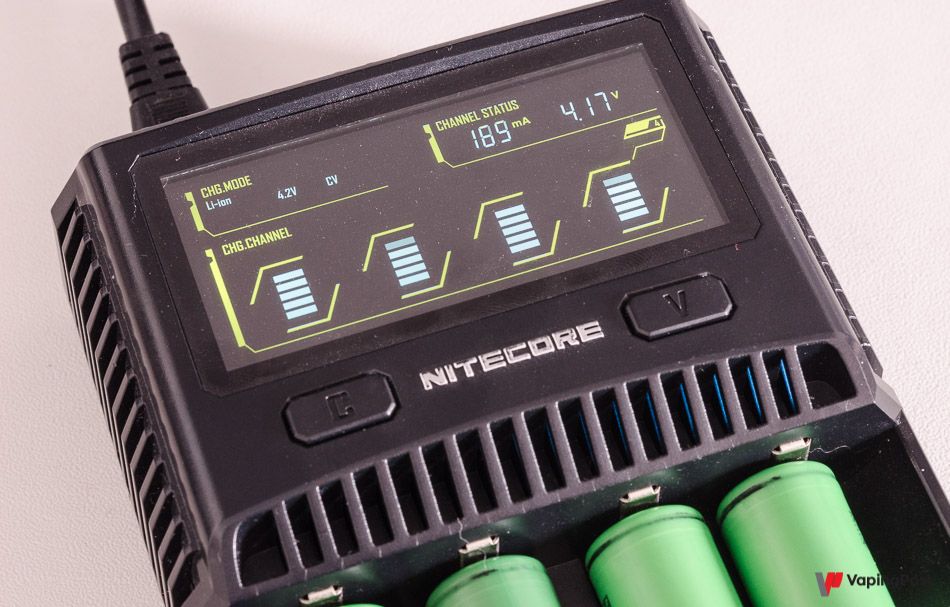 Therefore, you can charge your batteries at any time, most frequently when the box tells you to do so by displaying “low batteries”. Boxes generally do this when the battery voltage reaches 3.2 V, with some batteries such as DNAs offering the option to configure this threshold. Batteries can withstand their voltage dropping to 2.8 V without any problems – you can use this parameter for more battery life. They are actually designed for a minimum voltage of 2.5 V, which you should never exceed, as this is an absolute lower limit to ensure that they are not damaged. In a nutshell, charge your batteries when they are low or when it suits you, and everything will be alright.
Therefore, you can charge your batteries at any time, most frequently when the box tells you to do so by displaying “low batteries”. Boxes generally do this when the battery voltage reaches 3.2 V, with some batteries such as DNAs offering the option to configure this threshold. Batteries can withstand their voltage dropping to 2.8 V without any problems – you can use this parameter for more battery life. They are actually designed for a minimum voltage of 2.5 V, which you should never exceed, as this is an absolute lower limit to ensure that they are not damaged. In a nutshell, charge your batteries when they are low or when it suits you, and everything will be alright.
How should you charge your batteries?
Particular care needs to be taken in this regard, however. Firstly, charging quality have a major impact on the service life of batteries, but, above all, the safety of the operation must not be overlooked.
Don’t forget safety
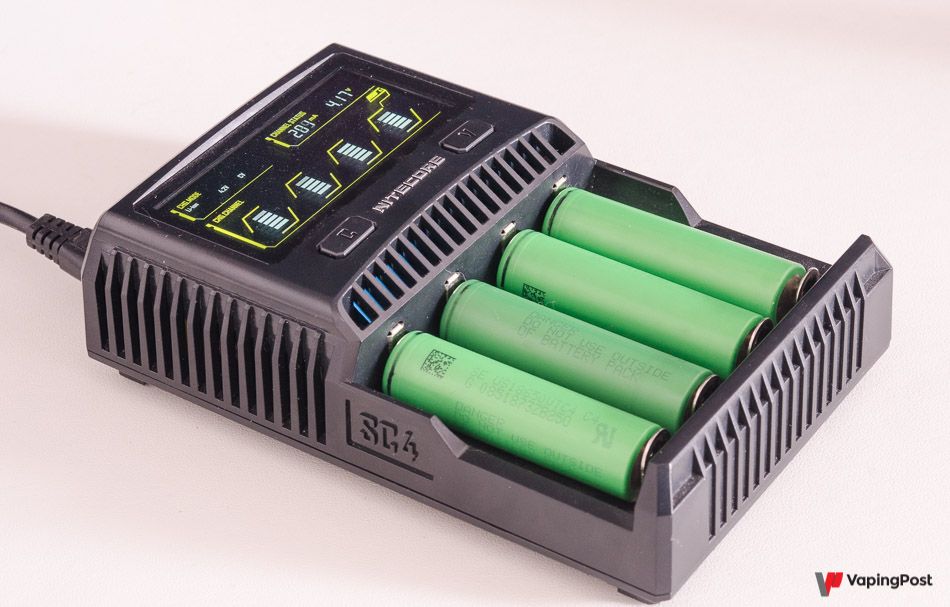 It is easy to remember safety concerns when using batteries, not so much when charging them, despite the fact that it is an integral part of their use! We don’t want to be alarmist: the risk of an incident when charging is extremely low. But it is not zero. The charger may have an operating fault (everything breaks down eventually), the battery may have a fault; in short, the risk of your battery catching fire while charging is a tiny, but nonetheless real, one. For this reason, always remember to leave the charger on a non-flammable surface, with nothing liable to catch fire on top of it either. You will be happy you did so if you are unfortunate enough to encounter such a one-in-a-million incident. However, steer clear of fireproof bags when charging. They are intended for transporting batteries and they work in this context, but they are not ventilated. Batteries heat up when charging, and in this type of bag, or in any confined place with no air circulation, the temperature can reach a critical threshold which will reduce the battery service life or, in a worst-case scenario, cause them to reach their ignition threshold. In short, allow your batteries to breathe when charging, don’t confine them in a bag. Along the same lines, avoid leaving batteries continuously in the charger, remove them when they have finished charging. Most chargers will stop charging, but some retain a low current which is detrimental to batteries. Finally, as discussed in our article on vaping and cold conditions, never charge a cold battery, wait for it to return to room temperature before charging it. Charging a cold battery causes metallic lithium to form inside, and believe me, you don’t want that to happen.
It is easy to remember safety concerns when using batteries, not so much when charging them, despite the fact that it is an integral part of their use! We don’t want to be alarmist: the risk of an incident when charging is extremely low. But it is not zero. The charger may have an operating fault (everything breaks down eventually), the battery may have a fault; in short, the risk of your battery catching fire while charging is a tiny, but nonetheless real, one. For this reason, always remember to leave the charger on a non-flammable surface, with nothing liable to catch fire on top of it either. You will be happy you did so if you are unfortunate enough to encounter such a one-in-a-million incident. However, steer clear of fireproof bags when charging. They are intended for transporting batteries and they work in this context, but they are not ventilated. Batteries heat up when charging, and in this type of bag, or in any confined place with no air circulation, the temperature can reach a critical threshold which will reduce the battery service life or, in a worst-case scenario, cause them to reach their ignition threshold. In short, allow your batteries to breathe when charging, don’t confine them in a bag. Along the same lines, avoid leaving batteries continuously in the charger, remove them when they have finished charging. Most chargers will stop charging, but some retain a low current which is detrimental to batteries. Finally, as discussed in our article on vaping and cold conditions, never charge a cold battery, wait for it to return to room temperature before charging it. Charging a cold battery causes metallic lithium to form inside, and believe me, you don’t want that to happen.
Box vs external charger
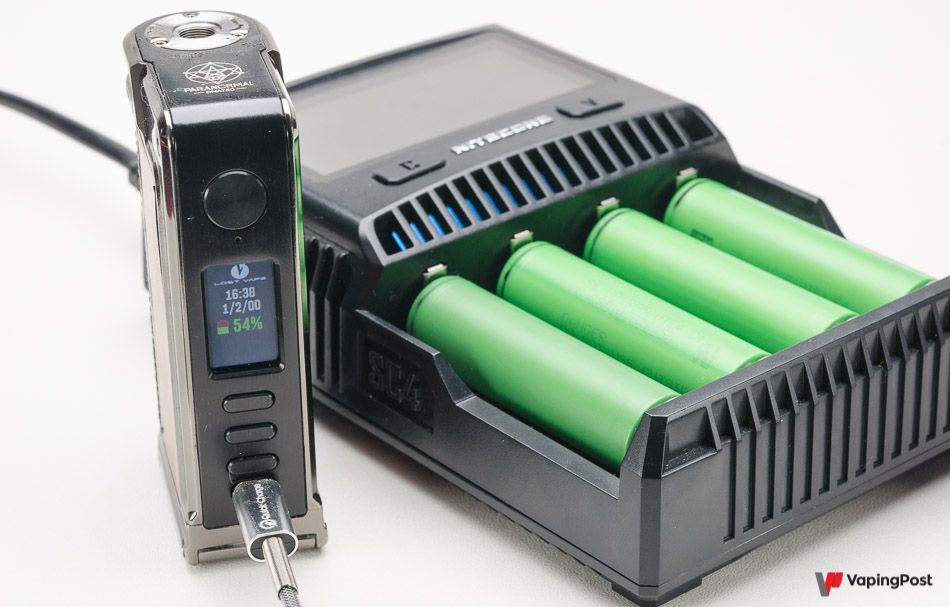 If you use an electronic box, it probably contains a USB port for charging the internal battery or batteries. The big question is whether it is preferable to use an external charger anyway, or not. The general answer is that it is actually preferable to use an external charger, but this response should be qualified so as not to overgeneralise. I will give a quick overview of the obvious practical advantages. An external charger is more cumbersome and represents an extra purchase, but it allows you to charge your batteries separately. You can have 2 sets of batteries, one in use and one charging, and therefore vape continuously without having to fiddle around with cables (USB in this case). The first argument in favour of external chargers is similar to that of fireproof bags: in the box, the battery is confined within a compact space, and the heat emitted due to charging builds up. On the other hand, in an external charger, the battery is in the open air. This is true, but should be moderated in that most built-in chargers contained in boxes have a relatively slow charge causing little heating of the battery. The charging rate is actually another argument in favour of external chargers, in particular for double- or triple-battery boxes. Most offer 1 A charging, which is split between the two batteries, for example to charge at 500 mAh each. Therefore, you would need 6 hours to charge a 3000 mAh battery, as opposed to half as much for most external chargers. Once again, this depends on the chargers, we will go into further detail on this point later. A further argument in favour of external chargers is the option to charge each battery individually, whereas a number of boxes charge them as a group, without a “balanced charge” mode. This argument is not true for single-battery boxes, but as soon as you have multiple batteries, the box needs to manage the charging of each battery individually. If your box runs on several batteries, check that they have a balanced charge mode, that is, independent charging for each battery. With external chargers at least, there is no issue, as they all have this mode.
If you use an electronic box, it probably contains a USB port for charging the internal battery or batteries. The big question is whether it is preferable to use an external charger anyway, or not. The general answer is that it is actually preferable to use an external charger, but this response should be qualified so as not to overgeneralise. I will give a quick overview of the obvious practical advantages. An external charger is more cumbersome and represents an extra purchase, but it allows you to charge your batteries separately. You can have 2 sets of batteries, one in use and one charging, and therefore vape continuously without having to fiddle around with cables (USB in this case). The first argument in favour of external chargers is similar to that of fireproof bags: in the box, the battery is confined within a compact space, and the heat emitted due to charging builds up. On the other hand, in an external charger, the battery is in the open air. This is true, but should be moderated in that most built-in chargers contained in boxes have a relatively slow charge causing little heating of the battery. The charging rate is actually another argument in favour of external chargers, in particular for double- or triple-battery boxes. Most offer 1 A charging, which is split between the two batteries, for example to charge at 500 mAh each. Therefore, you would need 6 hours to charge a 3000 mAh battery, as opposed to half as much for most external chargers. Once again, this depends on the chargers, we will go into further detail on this point later. A further argument in favour of external chargers is the option to charge each battery individually, whereas a number of boxes charge them as a group, without a “balanced charge” mode. This argument is not true for single-battery boxes, but as soon as you have multiple batteries, the box needs to manage the charging of each battery individually. If your box runs on several batteries, check that they have a balanced charge mode, that is, independent charging for each battery. With external chargers at least, there is no issue, as they all have this mode. 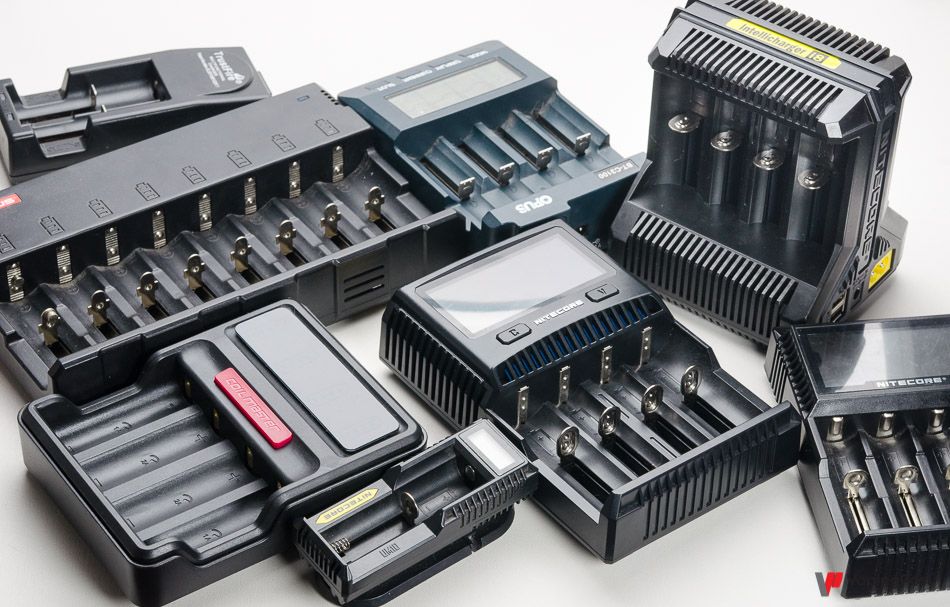 The final point is charging quality. Here, there is no universal answer. There are good and bad external chargers, like for box chargers. The good news is that there are very few bad chargers. Steer clear of any that charge batteries above 4.2 V, your batteries won’t like it. Some external chargers also have the advantage of giving you more information on battery charging and status, and also allow more advanced users to select specific parameters such as the charging current. In this instance, an external charger is fully justified.
The final point is charging quality. Here, there is no universal answer. There are good and bad external chargers, like for box chargers. The good news is that there are very few bad chargers. Steer clear of any that charge batteries above 4.2 V, your batteries won’t like it. Some external chargers also have the advantage of giving you more information on battery charging and status, and also allow more advanced users to select specific parameters such as the charging current. In this instance, an external charger is fully justified.
Charging current
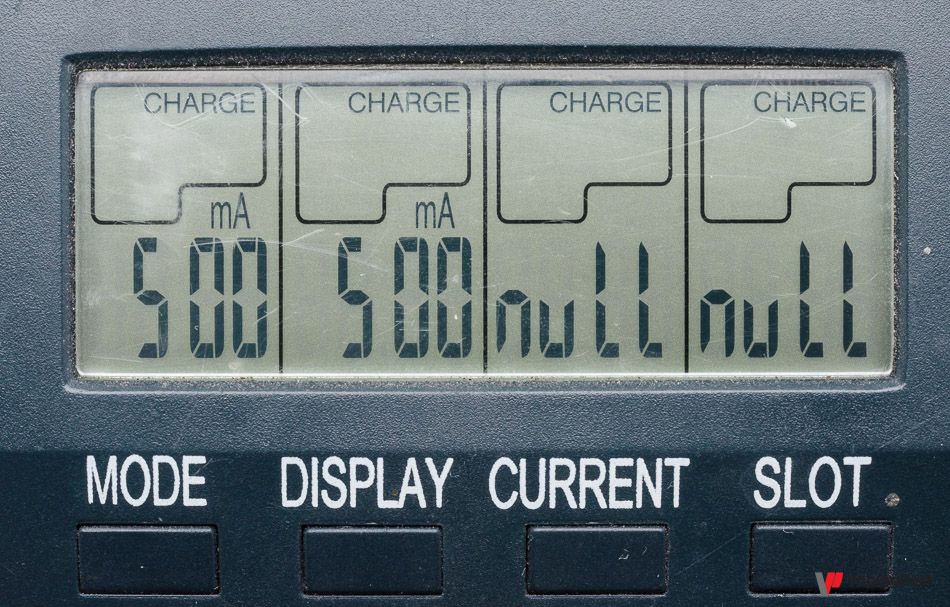 Some external chargers allow you to select the charging current, in milliamperes. The higher the current, the faster the charge, but it will also heat up the battery and age it more rapidly. Therefore, three charging current values can be assigned for a battery. The first value is the lowest, which extends the service life of the battery the most, i.e. increases the number of charge-discharge cycles that it can undergo before its performances are substantially degraded (an 80% reduction in its capacity is considered as the rating limit). This corresponds to slow charging. The second value is an intermediate value, the best compromise between battery preservation and charging speed. Note that the loss in terms of service life remains minimal compared to the previous value, and that this type of charging is in fact often the most practical and can be recommended generally. This corresponds to standard charging. The final value is the highest, and represents the maximum charging current value that the battery can withstand. This corresponds to fast charging. The charging process will be very quick, but the battery will not like it and will lose some of its performances each time. This type of charging is to be used occasionally when needed. but repeated use should be avoided, unless you want to replace your batteries every two months. The exact values are specific to each battery model; the best option is to refer to the manufacturer’s technical data sheet. You can get a rough idea with the battery discharge rate discussed in our article on battery specifications. Below you will find the table of different charging modes for the most common batteries used in vaping. Obviously, you should take particular care with the fast charging value. If you go over the standard charging value, the worst thing that can happen is that fast charging will take place, but if you go over the fast charging value, charging will wreak havoc on your batteries.
Some external chargers allow you to select the charging current, in milliamperes. The higher the current, the faster the charge, but it will also heat up the battery and age it more rapidly. Therefore, three charging current values can be assigned for a battery. The first value is the lowest, which extends the service life of the battery the most, i.e. increases the number of charge-discharge cycles that it can undergo before its performances are substantially degraded (an 80% reduction in its capacity is considered as the rating limit). This corresponds to slow charging. The second value is an intermediate value, the best compromise between battery preservation and charging speed. Note that the loss in terms of service life remains minimal compared to the previous value, and that this type of charging is in fact often the most practical and can be recommended generally. This corresponds to standard charging. The final value is the highest, and represents the maximum charging current value that the battery can withstand. This corresponds to fast charging. The charging process will be very quick, but the battery will not like it and will lose some of its performances each time. This type of charging is to be used occasionally when needed. but repeated use should be avoided, unless you want to replace your batteries every two months. The exact values are specific to each battery model; the best option is to refer to the manufacturer’s technical data sheet. You can get a rough idea with the battery discharge rate discussed in our article on battery specifications. Below you will find the table of different charging modes for the most common batteries used in vaping. Obviously, you should take particular care with the fast charging value. If you go over the standard charging value, the worst thing that can happen is that fast charging will take place, but if you go over the fast charging value, charging will wreak havoc on your batteries.
| Battery | Slow charge | Standard charge | Fast charge |
| LG HB6 | 0.5 A | 0.75 A | N/A |
| LG HE4 | 0.75 A | 1.25 A | 4 A |
| LG HG2 | 0.75 A | 1.25 A | 4 A |
| LG MJ1 | 0.7 A | 1.7 A | 3.4 A |
| Samsung 25R | 0.75 A | 1.25 A | 4 A |
| Samsung 30Q | 0.75 A | 1.5 A | 4 A |
| Sony VTC4 | 1 A | 2 A | 4 A |
| Sony VTC5 | 1.5 A | 2.5 A | 4 A |
| Sony VTC5A | 1.5 A | 2.5 A | 6 A |
| Sony VTC6 | 1.5 A | 3 A | 5 A |
| Sanyo NCR18650GA | 0.7 A | 1.675 A | N/A |
To find out more…
Batteries are a huge topic; we have written a series of articles examining the question.
- Buying the right battery is good, but keeping it longer is even better! For this reason, we have compiled a comprehensive tutorial on extending the service life of your batteries.
- However, a drop in battery performances, a battery impact or breach of the protective sleeve is bound to happen eventually. It is important to know when to replace a battery and how to dispose of it.
- For those who want to find out more, our article on key battery characteristics explains everything you need to know about the battery capacity and maximum discharge current, and how they are determined.
- And if you want to understand how to optimise your battery choice and use, our article on battery specifications goes into more detail on the concepts of internal resistance, voltage sag, rated voltage, and provides details on the different chemistries.
- Finally, if you are one of the many people who believe the serial / parallel battery configuration or set-up resistance to have some importance in terms of battery life or the current drawn from batteries in an electronic box, our article on choosing batteries in an electronic box is for you.
- On another note, an article on e-cigarette battery explosions. As the media feast on these stories, despite them being extremely rare, we thought it was important to review this explosive topic to understand it, and above all prevent it from happening to you.
Don’t forget!
- Never use a battery beyond its specifications, both for battery life and your safety.
- Always carry batteries in suitable protection; most of the rare accidents that occur are linked with transporting unprotected batteries.
- Only use batteries that are in perfect condition, free from scratches or impacts.
- Never throw a battery away, place it in a specific recycling container.








